
|

|

|

|

|

|
| Home | Manuals | Supplies | Search | Consult | Contact | Testing | Service |
|
Lock and Cancel How It Works A Mechanical/Pneumatic Lock and Cancel device works quite differently from a regular Lock and Cancel (L-and-C) device. With a regular L-and-C device, one signal locks one valve 'on' and it stays 'on' until another signal comes along that locks another valve 'on', which in turn unlocks the other valve. This is explained in great detail here. The system that will be explained below, looks like the one that's pictured below. 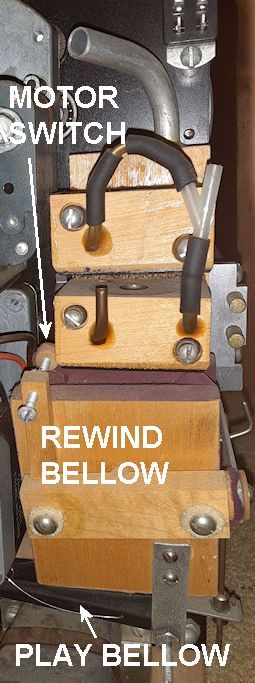 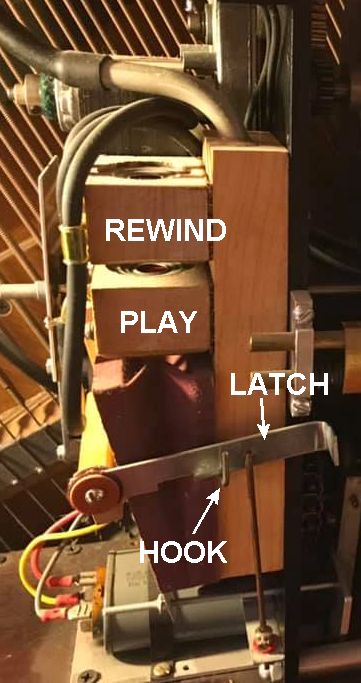 What is not clearly obvious or explained here in any great detail is the fact that the Rewind bellows actually has two jobs. One is to shift the roll frame from the Play mode to the Rewind mode. The other job is to activate a switch (Motor Switch) which turns off the voltage to the Play motor and applies voltage to the Rewind motor. There is also an adjustment which is set such that the Rewind motor starts turning at the same moment the roll frame has latched into Rewind. The next two diagrams show the Rewind and Play valves and the Mounting Block, which shows the channels through which the vacuum travels from the valves to the bellows. 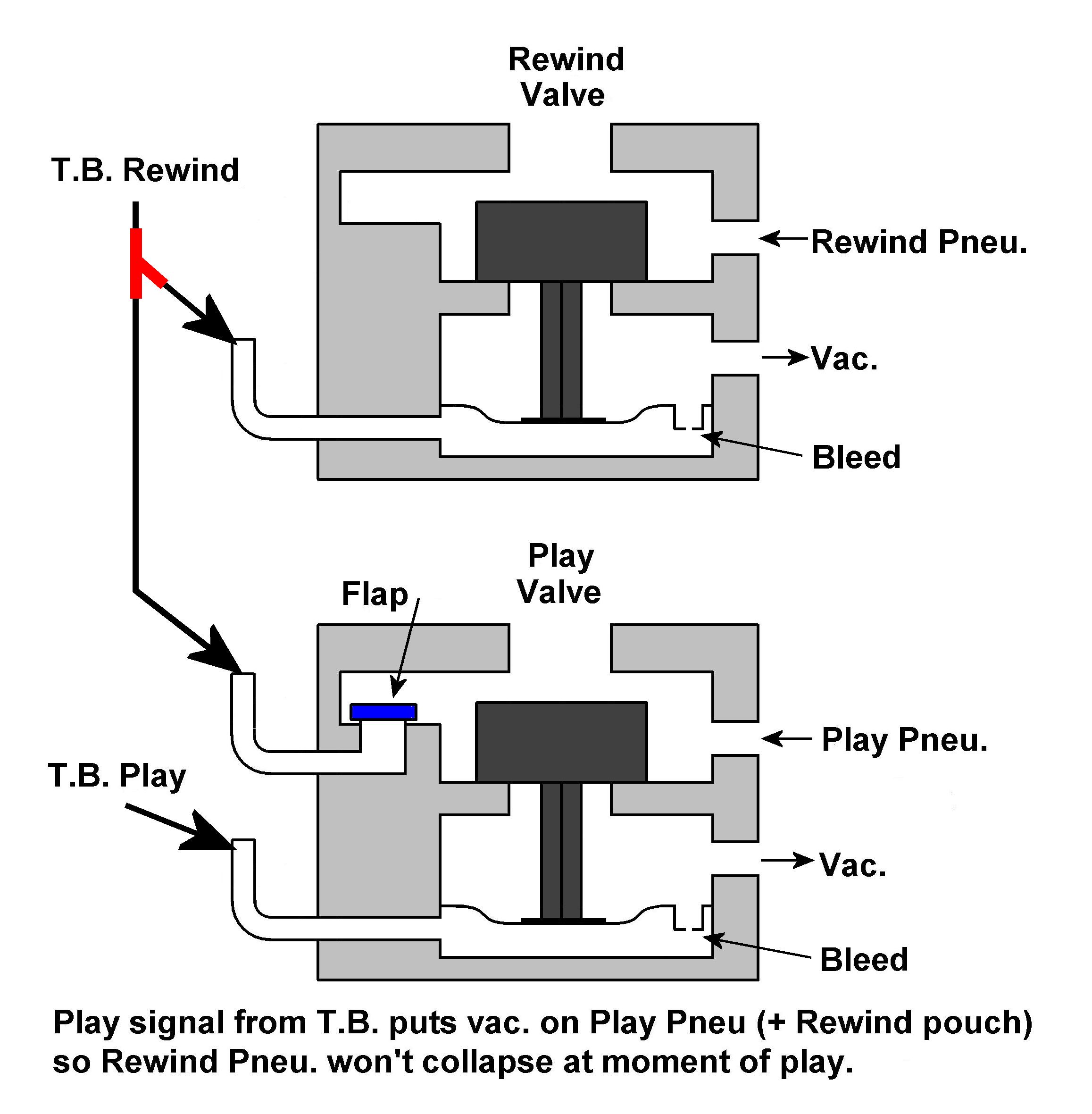 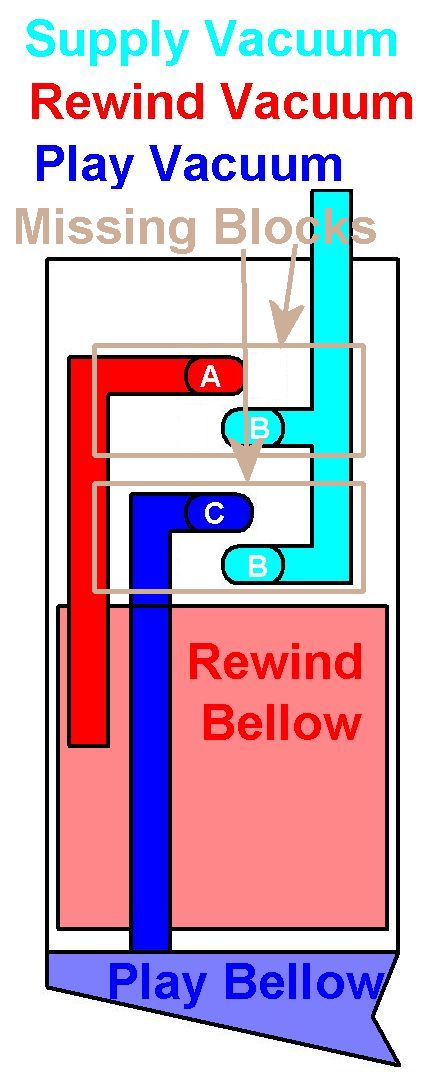 Unlike a common L-and-C device, this device utilizes a mechanhical lock (referred to as a 'latch') to lock the roll frame into Rewind and a spring-loaded bellows (the Play Bellow) to release the latch at the end of the rewind cycle. Perforations in the music roll tell the valves when to shift into Rewind and Play. Both valves are only "on" when the perforations are present. So, in that sense, they are never 'locked' on or off. Considering the mechanical aspects of this system, one might presume that two ordinary valves would do the job nicely. And, in theory, that's true. However, in reality, there was a problem. While the system would faithfully go into Rewind, it wouldn't always go back into Play. To solve the problem, the Play valve was modified. Simply put, it was modified such that the Rewind valve could not turn 'On' when the Play valve was turned 'On'. Referring to the above diagram of the valves, notice the part marked 'Flap' (in blue) and notice that there's a 'Y' connector (in red) in line with the Rewind signal from the trackerbar (T.B.). Also notice the bleed cups in both valves. When the system is at rest, there is vacuum in the line marked T.B.Rewind, which is supplied by the bleed in the Rewind Valve. At the same time, there is atmosphere in the top section of the Play Valve. So, the Flap is kept closed by the vacuum in the Rewind Valve pouch well. Now, referring to the diagram below, it is assumed that a Play signal, from the music roll, has cause the Play Valve to change state (to come 'On'). At the instant that the valve comes 'On', there is vacuum in the upper chamber of the Play Valve. So, two things happen. One, the Play bellows collapses, which unlatches the Latch, allowing the Rewind bellows to relax (or open). This in turn shifts the roll frame back into the Play mode and applies voltage to the Play motor. Two, since the oriface that the Flap normally covers is as large as the oriface that would otherwise supply the signal to trigger the Rewind Valve to change state (or come 'On'), the Rewind Valve cannot come 'On' even if a signal were present. Stated differently, this action prevents the Rewind Valve from being activated even if the T.B. Rewind port were to open. This is true because if atmosphere was present at the 'Y' connector, it would be equalized by the vacuum in the Play valve. 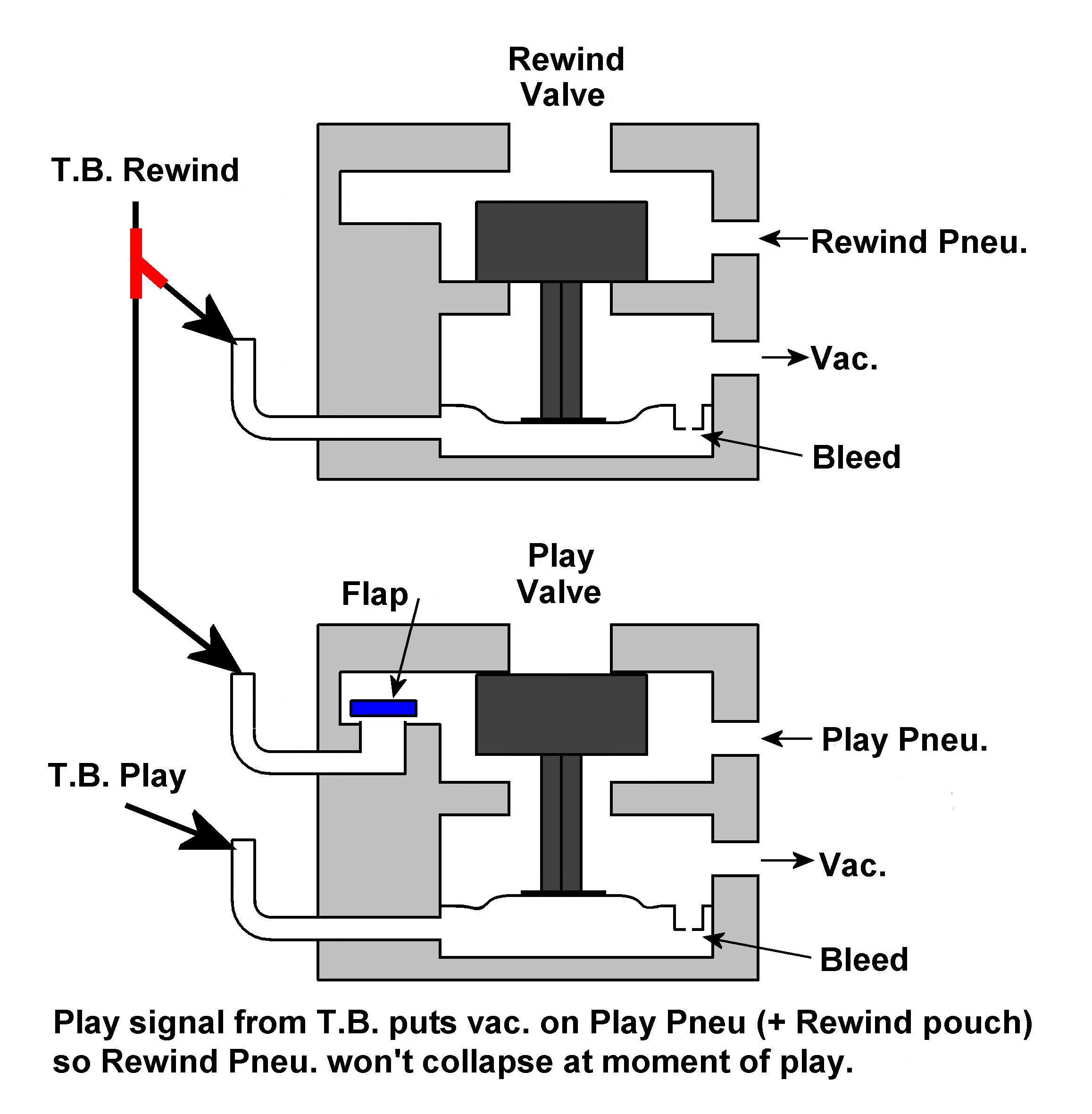 The not so obvious question might be: But why would the Rewind Valve even try to come 'on'? Isn't the paper on the trackerbar covering the Rewind port? Generally speaking, the Rewind Valve won't try to come 'on' because the paper is covering the bar. However, that's only true in theory. In reality, what happens, more often than not, is that the music paper lifts away from the trackerbar at the moment that the roll frame shifts from Rewind to Play. This happens for two reasons. One, due to the speed at which the roll is rewound, the music roll has a lot of momentum, and even though there is a brake which provides tension to keep the roll snugly rewound, the sudden stop causes the roll to 'bounce' in the opposite direction, which lifts the paper off of the trackerbar for an instant. Two, there is almost no vacuum holding the paper to the trackerbar. During normal Play, vacuum from the bleeds in the entire system (notes, instruments, and devices) aids in keeping the paper 'pulled' against the trackerbar. During Rewind, all of those things except the Play and Rewind valves are cut off. In closing, I want to give credit to Art Reblitz from providing a hand drawn diagram that he made up when working on a Player Piano Co. spoolbox that's in an Empress nickelodeon called the 'Ghost Town', which uses 'A' rolls. His diagram was invaluable in helping me to understand what Paul Manganaro and Craig Brougher referred to as Wurlitzer valve blocks with a flap inside. I also want to thank Paul and Craig for putting up with my many questions and the help they provided. |

![]() ..To
The Top of this Page . . . . . . . . . . .
..To
The Top of this Page . . . . . . . . . . . ![]() ..To The HOME Page
..To The HOME Page
|
Since "Player-Care" is an internet business, I prefer that we correspond via E-Mail (click here to fill out the 'Request Form'). However, if I'm not in the middle of some other activity, you can reach me at 732-840-8787. But please understand that during the hours from 8AM-5PM EST (Mon-Sat), I'm generally quite busy. So, I probably won't answer the phone. If you get the answering machine, please leave a detailed message stating the reason for your call. Also, repeat your name and phone number clearly and distinctly. By necessity, I prioritize everything in my life. And, if you call and just leave your name and number, and ask me to call you back, it might be a day or two before I return your call. Why? Because I don't know why you want me to call and I might not be prepared to assist you in an effective and efficient manner. If you leave me an E-Mail address (which I prefer), spell it out phonetically. The more you do to help me, the more I can help you in return. Don't rush. You have four minutes to record your message. |
|
407 19th Ave, Brick, NJ, 08724 Phone Number 732-840-8787 (Voicemail Only, No Texts) |
